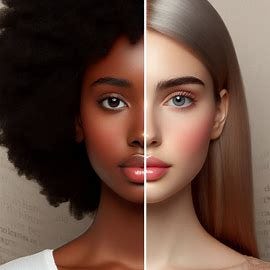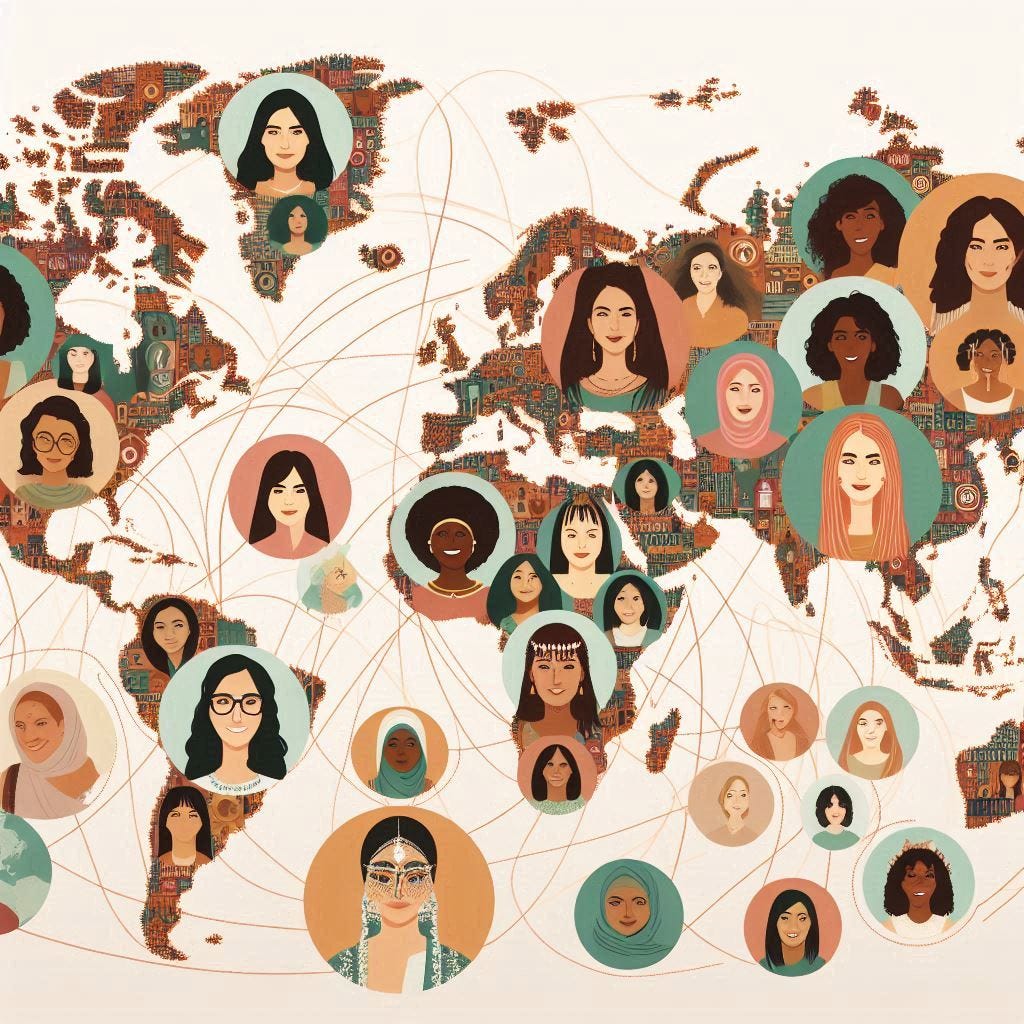Introduction
Is there a right way to be a woman? This is a question that has continued to pop in my head. Considering the controversy surrounding the “validity” of some women’s womanhood at the 2024 Paris Olympics. Athletes like Imane Khelif found their very identity questioned based on their appearance.
Whenever we think ‘woman’, this picture always pops up in our minds: a voluptuous, demure, soft-ish, caring, and nurturing person - with slight variations to the picture depending on the region and some other factors.
The Media’s Role in Shaping Expectations
And the media is not helping. From magazines to movies, we are bombarded with this picture of how a woman should look and what she should be able to do.
Once a girl is born, she is placed in society’s box. And she dare not step out for fear of being called ‘ugly’.
In a society that demands that women be fat but only in their boobs and their ass but none in their stomachs. They should be toned, but not so much that they look as though they are competing with a man.
They should have a nice jawline, something sharp. But not too sharp, we don’t want them looking like a “man”.
They should be confident and have their own money because no man wants a burden or a woman he can walk all over, but not too confident that the man feels threatened.
Honestly, I’d call it a maze, not a box because it is just as confusing. Because tell me, what exactly does society want?
The Ever-Changing Beauty Standards:
Throughout history, women's bodies have been molded like clay, not by the hands of the creator but by the relentless hands of societal expectations. We all have been compressed, stretched, bent, reshaped, and even broken to fit into the ever-changing mold of "beauty."
As the 90s dawned, the beauty standard became Victoria's Secret angels and their impossible figures. Suddenly, the beauty standard shifted to being both whisper-thin and impossibly busty—a biological contradiction that sent many scrambling for surgical solutions.
College students, and high school students emptied their savings, risking their health for breasts that looked comically out of place on their frail frames. And those who couldn’t afford a boob job resorted to push-up bras and padding their chests.
Our fuller-figured sisters faced an even more Herculean task: losing weight everywhere except their chests. Some resorted to dangerous eating disorders, their bodies becoming battlegrounds in a war they could never win.
But this was not restricted to only body size. Even facial features were scrutinized. Thin lips were praised as "perky," while our sisters blessed with full, luscious lips were cruelly dubbed "porky."
The 2000s ushered in the era of the Kardashians, and with their reality show another unattainable beauty standard. Suddenly, full lips were "in"—not because of the countless Black women who had been mocked for generations, but because Kylie Jenner got fillers. Curvaceous behinds became desirable, not in celebration of natural diversity, but because Kim had sculpted herself into an hourglass fantasy.
You might think this shift would be a victory for Black women, but it was a hollow one at best. Our bodies, in all their glorious variety, were still being judged against an artificial standard. Because the Kardashians sold a lie: that their cartoonish proportions were achievable through mere diet and exercise. They peddled the fantasy of having it all—huge breasts, tiny waists, and rounded hips—without acknowledging the army of surgeons hiding just behind the curtain.
What happens when women are forced to conform to different beauty standards every decade? You are left with women with severe body dysmorphia, physical and psychological damage. You are left with women who will never find themselves beautiful because they compare themselves each day to impossible beauty standards.
Women In Sports: Breaking The Mold:
While society continues to grapple with these ever-shifting beauty ideals, there's one arena where women's bodies refuse to conform to these narrow standards: the world of sports.
Women are expected to look dainty and curvy even as athletes. But, omo no be so. Because you can’t expect a person to do rigorous exercise in preparation for some next-level competition, and their body will not change.
Men’s bodies change constantly, and no one bats an eye. The cyclers look real lanky and thin, and no one asks why they aren’t buff.
But because it’s women, we are expected to be “perfect” - at least what society believes to be “perfect”.
Our identities are constantly questioned.
She isn’t a “real” woman, her shoulders are too broad.
She isn’t a woman, she runs too fast. She plays too well. She is too good. It’s not possible.
She isn’t a real woman, her jawline is too sharp.
Women in sports are repeatedly told that they aren’t real, good enough, complete women because they don’t look a certain way.
I’m quite young, but even I remember a little bit of how Serena Williams was mocked and bullied because of her body. It was mostly hatred and jealousy that a woman could be that awesome at sports.
And that’s still part of what we’re saying. A woman can’t be so good at sports in society's small mind. After all, it is a man’s thing. Then, to top it all, Serena dared to look like she played sports. What with the muscles and all? I guess it was too much for people to handle.
Even Imane Khelif, faced serious backlash and cyberbullying because she didn’t fit into the mold of what a woman should look like. Or what a woman who plays sports should look like.
She was told that she wasn’t a real woman. That she wasn’t a woman at all.
She was called a man. She was harassed to the point that her father had to bring out her birth certificate to show the world that she was born a woman.
No woman should have to prove that she is a woman. No one should have to prove their gender to the world. If someone says they’re a woman, take it like that because “woman,” doesn’t have a look.
Even we women are not completely innocent from perpetuating these harmful beauty standards, especially those of us who are lucky or unlucky enough to have these features which are considered the standards for beauty. You might chuckle at how ironic this situation is, but I promise you, nothing is funny about it.
Now, we have fallen to the level where we expect men to be misogynistic by default. These days, it is more like expecting water to be wet, but when women join the misogyny party? It just doesn't make sense.
Why? Because we are supposed to know better.
Call it internalized misogyny, wrong upbringing, or self-hate - it all hurts the same. It is very easy to identify these patriarchal princesses. I mean, if it walks like a duck, or quacks like a duck, it is most likely a duck.
But when women who identify as feminists and advocate against female oppression suddenly turn against their own principles, it is surprising, to say the least.
Et tu Rowling?
The four-day Twitter tirade of the Harry Potter writer, including misgendering Imane demonstrates how even prominent figures can betray feminist ideals. Because it was not enough for Imane to identify as a woman, and be raised as a woman - she had to look like a woman, or better put, she had to look like what society believes a woman should look like.
The Intersection of Race and Beauty Standards:
The women who had failed to fit into these beauty standards over time were mainly black people and people of color. With prominent features, women of color have over time been called manly and other hateful things because of what they look like.
This behavior goes beyond misogyny, often intersecting with racism. The concept of "white women's tears" illustrates how some white women leverage their racial privilege against women who don't fit Eurocentric beauty standards. Even today, it would seem that having female anatomy or identifying as a woman is insufficient – there's an unspoken requirement to look a certain way to be considered "truly" female.
This raises a critical question: How can women protect and uplift each other when some are actively undermining the very foundations of solidarity and inclusivity?
The Nigerian Perspective:
Here in Nigeria, things are a bit different. Unlike in the Western world, where thinness is prized, Nigerian culture tends to celebrate and adore women with fuller figures. But before you clock this as a win, this preference has also led to an unexpected consequence: the body shaming of slimmer women. Different scales: same outcome.
Comments like “Eat something,” “You look like a broom” etc are often flung at unfortunate women who did not have the luck of a body that was considered the standard.
And when you think that you could be able to live with this, here comes colorism. Companies of different sizes all have one marketing strategy: stamp the picture of a light-complexioned woman on the front of their products, coupled with the tag “Brightening or Whitening in 7 days.” This was all it took for teenagers to spend their piggy bank savings on creams which promise to lighten up their complexion.
And you might be wondering, Oh, but nobody asked them to bleach their body. Nobody needed to. Light-complexioned people were preferred over dark-complexioned ones. They were admired more, they were more likely to be seen or selected for significant positions. It was almost like you had to be light-complexioned to be beautiful.
But it is not just physical appearance with societal demands of who and what a woman should be. There were things women could do and couldn’t do.
A woman cannot be a President. I heard that first in high school. I argued that a woman could, that there was nothing in our biology that was preventing us from becoming presidents. Then, the argument became that a woman shouldn’t be one. I soon realized that I was lied to - women could be presidents; society just didn’t want them to be.
They said, “You can dream big, but not too big.” “Want to be President? Oh, honey, don’t you know? Being a president is a man's job. But don't worry, you can always be the wife to the assistant of the man who might one day shake hands with the President. Isn't that just as exciting?”
Our grandmothers, God bless their hearts, prayed for us to marry Governors but never for us to be the Governor. It was always “You’ll marry a rich man, but never you’ll be the rich man”.
How did we all get here? It starts with stamping on little kids' dreams right there in elementary school. It began with telling young girls in classrooms “Oh you cannot become a class prefect, but you can be a man’s job. You can only be an assistant. That is also as important.”
If it was the same, why can’t a woman do that job?
And let's not forget the golden rule of being a complete woman in Nigeria: thou shalt not be considered a complete woman until you have a wedding ring on thy finger and a baby on thy hip.
Single woman? Incomplete.
Married but childless? Half-baked.
Only have daughters? What a pity.
Divorced or a single mother? Oh boy, or should I say, oh girl?
Always be ready for those sympathetic head tilts and the not-so-subtle prayers for God to bring another man along your path.
The only thing worse than being single in this country is having been not single and then single again.
Recently, with the rise of social media and black-centric movements, we have seen more and more black women centering the BLACK IS BEAUTIFUL motto because sometimes, we need to sit up and tell women that they are beautiful, regardless of what society says.
When I was 14 or 15, I first watched a Chimamanda Adichie speech and one of the things that stood out to me was her hair, and how beautiful it was. Little by little, the change began to creep in. Suddenly, it was now cool to wear your natural hair, the way it is. Actresses like Nse Ikpe Etim, and Kate Henshaw joined in and soon girls of different ages began to abandon the creamy crack for lovely Afro.
Have you thought about the increase in gym culture? When I was younger, it was not so. Women stayed out of the gym because to go to the gym means that you will get muscles. And muscles made you manly. I still remember the comments under Kate Henshaw's IG posts those days. I’m not saying that everything is all better now, but things are definitely looking up.
What changed? Little significant effort to be different. Because if bullies don’t crack you, being different eventually becomes cool. Because there is no right way to be a woman. A woman can be anything she wants to be.
Let's face the truth, ladies: we have all been lied to. This lie has been sold to us by generations past, and we have been playing by someone else's handbook for far too long. I am tired. You should be tired as well. It is time we throw that outdated manual out the window and start writing our own stories with our own hands, by ourselves.
Winds of Change
Because we are all distinctly different. And there’s no way we all can fit into one box. We are not mass-produced dolls, for crying out loud. And it starts with rebellion.
Remember when wearing pants was considered "unwomanly" especially in this part of the world? Now, we have women rocking everything from saris to pantsuits, and hijabs to crop tops. Why is that? Because someone rebelled. Someone became the first person to wear trousers in your community and church, and it soon became normal to wear trousers. Because the only right way to be a woman is to create your own way and style.
And we need everyone on this journey. Everybody. Let us celebrate the tech sis in her geeky glasses and her hoodie. Let us also celebrate the stay-at-home mom and the child-free career woman the same way. The introvert and the loud, proud activist. They're all women, period. No asterisks, no footnotes. All women. And they are all “the right way to be a woman”
And then, the game changers: education and media. The weapon we have. It is time to rewrite our textbooks. Remember how they only contained pictures of mums in the kitchen and dads at workplaces? Yup. It is time to change the script. Show children that women can do both. It is time to teach our children about women scientists, athletes, leaders, and innovators. Not as exceptions, but as the norm.
And the media and entertainment? Roll up your sleeves and get to work. For every "damsel in distress" story they see, show them ten heroines who save themselves. For every Cinderella story, show them Brave. Magazines should push diversity. Showcase real bodies. Let women of all ages, sizes, colors, and backgrounds living their best lives be displayed for the entire world to see.
And then let’s look at ourselves -women. Sometimes, society can only be loud, and at the end of the day, it is about what a woman decides for herself.
Want to be a CEO? Go.
Prefer to be a homemaker? Do it.
Want to be both? Why the hell not?
The point I am trying to make is this: it's your choice. Your life. We need a world where every girl grows up knowing she has the right to define herself, and we have to create it ourselves. It's time we stop asking women to shrink themselves to fit into society's narrow definition. Girl, shatter those expectations.
Conclusion
Because the truth is this: there's no one right way to be a woman. Instead, there are 3.9 billion right ways—one for each woman on this planet. And every one of these ways is valid, valuable, and worthy of respect.









Awesome 💯